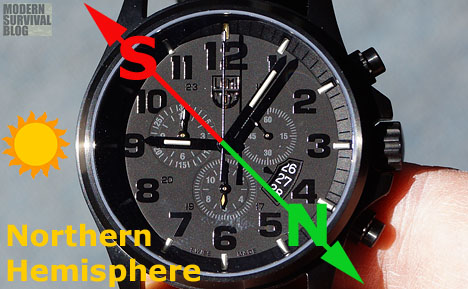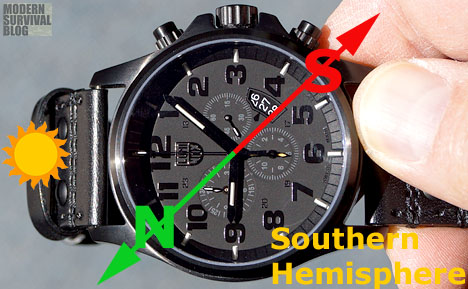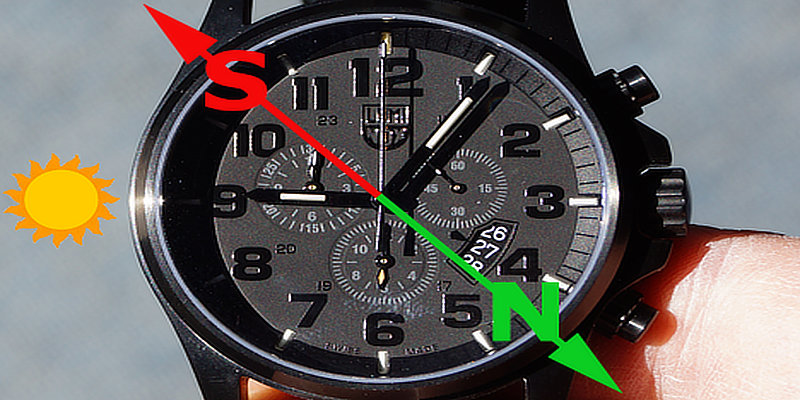How To Use A Watch As A Compass
It’s surprisingly simple and easy how to use a watch as a compass. It only requires having enough sunlight to cast a shadow from a twig. And, of course, an analog watch.
If you ever become lost, and do not have a compass, you can easily discover your general direction by establishing a North-South line from your analog wrist watch. It’s not exact, and there are a few caveats. However it’s close enough to orient yourself.
Note: This method works accurately at the equinoxes, because during the rest of the year the sun is not at the meridian (directly north if you are in the southern hemisphere). However, it’s still close enough to get you out of a jam.
Here’s more about using a watch as a compass.
Using Watch As A Compass In The Northern Hemishpere

Align the shadow of a twig with the hour hand
Align a twig (pointing straight up) at the edge of your watch so that it casts a shadow onto the face of the watch from the sun.
Then while holding the twig steady, rotate the watch until the twig’s shadow is cast directly onto the position of the hour hand for the current time.
In other words, you’re aligning the shadow with the hour hand (you’re pointing the hour hand in the direction of the sun).
One caveat: It’s important to hold the twig straight up, rather than at an angle for a more accurate result.
Bisect the angle between the hour hand and 12-oclock
Bisect the angle between the hour hand and 12-oclock. This halfway point between the hour hand and the 12-oclock position is your North-South line.
Another caveat: If your watch is set to daylight savings time, use the halfway point between the hour hand and 1 o’clock to determine the north-south line.
To determine which end of the line is north or south, remember this…
- The sun rises in the east, and is in the east before noon.
- The sun is due south at noon.
- The sun sets in the west, and is in the west after noon.
During the summer, the sun rises in the Northeast, goes around very high to South at noon, and sets in the Northwestwest. During the winter, the sun rises in the Southeast, keeps low to the South at noon, and sets in the Southwest.
So I originally posted this article, How to use a watch as a compass, nearly a decade ago. I came across the article again, so I decided to double-check myself.
Borrowed Mrs. J’s Timex and headed outside. Quickly found a twig. Set the watch on the hood of the truck and oriented/aligned the the hour hand of the current time with the shadow from the twig. It’s summer, so daylight savings time. Therefore I bisected between the 9-oclock and 1-oclock. Sure enough, the North-South line was pretty close to where I know it to be…
TIMEX 38mm
(amzn)

Using Watch As A Compass In The Southern Hemisphere

Align a twig (pointing up) at the edge of your watch so that it casts a shadow onto the face of the watch from the sun.
Then while holding the twig steady, rotate the watch until the twig’s shadow is cast directly onto the 12-oclock mark.
In other words, you’re aligning the shadow with the 12-oclock mark (you’re pointing the 12-oclock mark in the direction of the sun).
The halfway point between 12-oclock and the hour hand is your North-South line.
[ Read: Find East – West with a Stick and the Sun ]
[ Read: How to Find North – South At Night ]

